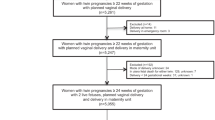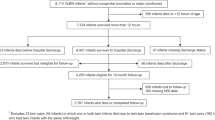Abstract
OBJECTIVE: To compare the perinatal outcome of the presenting twin to its co-twin.
STUDY DESIGN: All live nonanomalous twin gestations delivered at >25 weeks' gestation between 1984 and 1994 (N=461) were identified. Twin A was compared to twin B regarding the following variables: presentation, Apgar score (AS) <4 at 1 minute, AS <7 at 5 minutes, birth weight, gender, traumatic delivery, meconium-stained amniotic fluid, cord prolapse, need for mechanical ventilation, intraventricular hemorrhage, respiratory distress syndrome, sepsis, seizures, perinatal mortality, and length of nursery stay.
RESULTS: Except for differences in presentation, the perinatal outcome was similar in both twins regarding variables studied. This continued to hold true after subdividing according to mode of delivery, when infants with birth weight ≤1500 g were considered separately, and when vaginally delivered cephalic twin A was compared to the noncephalic co-twin. However, differences in some outcome variables became evident when pregnancies with only one affected member were analyzed separately.
CONCLUSIONS: When all twin pairs are considered, the outcome of the second-born twin is similar to that of the first-born regardless of the mode of delivery, presentation, or birth weight ≤1500 g. If only those twin pairs with one affected and one unaffected twin are considered, it becomes apparent that the presenting twin is at increased risk for infection-related morbidities whereas the co-twin is at risk for other complications.
This is a preview of subscription content, access via your institution
Access options
Subscribe to this journal
Receive 12 print issues and online access
$259.00 per year
only $21.58 per issue
Buy this article
- Purchase on Springer Link
- Instant access to full article PDF
Prices may be subject to local taxes which are calculated during checkout
Similar content being viewed by others
References
Prins RP . The second-born twin: can we improve outcomes? Am J Obstet Gynecol 1994; 170: 6 1649–56
Nakano R, Takemura H . Birth order in delivery of twins Gynecol Obstet Invest 1988; 25: 217–22
Young BK, Suidan J, Antoine C, Silverman F, Luseig I, Wasserman J . Differences in twins: the importance of birth order Am J Obstet Gynecol 1985; 151: 915–21
Eskes TK, Timmer H, Kollee L, Jongsman HW . The second twin Eur J Obstet Gynecol Reprod Biol 1985; 19: 159–66
Laros RK, Dattel BJ . Management of twin pregnancy: the vaginal route is still safe Am J Obstet 1988; 158: 1330–8
Chang TH, Jeng CJ, Lan CC . The effect of birth order in twins on fetal umbilical blood gas and Apgar score Chung-hua I Hsueh Tsa Chih (Taipei) 1990; 36: 3 156–60
Derom R, Thiery M . Fetal acidosis in second twins Acta Genet Med Gemellol (Roma) 1970; 19: 1 91
Morales WJ, O'Brien WF, Knuppel RA, Gaylord S, Hayes P . The effect of mode of delivery on the risk of intraventricular hemorrhage in nondiscordant twin gestations under 1500 g Obstet Gynecol 1989; 73: 107–10
Hacking D, Watkins A, Fraser S, Wolfe R, Nolan T . Respiratory distress syndrome and birth order in premature twins Arch Dis Child Fetal Neonatal Ed 2001 Mar; 84: 2 F117–21
Buekens P, Wilcox A . Why do small twins have a lower mortality rate than small singletons? Am J Obstet Gynecol 1993; 168: 937–41
No authors cited Second twins Br Med J 1968; 2: 606 641
Chen SJ, Vohr BR, Oh W . Effect of birth order, gender, and intrauterine growth retardation on the outcome of very low birth weights in twins J Pediatr 1993; 123: 1 132–6
Pearlman SA, Batton DG . Effect of birth order on intraventricular hemorrhage in very low birth twins Obstet Gynecol 1988; 71: 3 pt 1 358–60
Norman RJ, Jourbert SM, Marivate M . Amniotic fluid phospholipids and glucocorticoids in multiple gestation Br J Obstet Gynaecol 1983; 90: 51–5
Law RG . Standards of Obstetric Care The report of the North West Metropolitan Regional Obstetric Survey, 1962–1964 Edinburgh: Livingston 1967
Robertson JG . Twin pregnancy: morbidity and fetal mortality Obstet Gynecol 1964; 23: 330–7
Hendricks CH . Twinning in relation to birthweight, mortality, and congenital anomalies Obstet Gynecol 1966; 27: 47
el-Jallad MF, Abu-Heija AT, Ziadeh S, Obeidat A . Is the second-born twin at high risk? Clin Exp Obstet Gynecol 1997; 24: 4 226–7
Gibson NY, Graves GR, Rawson TW, LeBlanc MH, Meydrech EF . Effect of birth order on incidence of periventricular–intraventricular hemorrhage in very low birth weight twins South Med J 1996; 89: 12 1156–8
Creig PH, Veille JC, Morgan T, Henderson L . The effect of presentation and mode of delivery on neonatal outcome in the second twin Am J Obstet Gynecol 1992; 167: 901–6
McCarthy BJ, Sachs BP, Layde PM, Burton A, Terry JS, Rochat R . The epidemiology of neonatal death in twins Am J Obstet Gynecol 1981; 141: 252–6
Ziadeh SM, Badria LF . Effect of mode of delivery on neonatal outcome of twins with birthweight under 1500 grams Arch Gynecol Obstet 2000 Nov; 264: 3 128–30
Wyshak G, White C . Birth hazard of the second twin J Am Med Assoc 1963; 186: 869
Naeye RL, Tafari N, Judge D, Marboe CC . Twins: causes of perinatal death in 12 United States cities and one African city Am J Obstet Gynecol 1978; 131: 267–72
Author information
Authors and Affiliations
Rights and permissions
About this article
Cite this article
Usta, I., Nassar, A., Awwad, J. et al. Comparison of the Perinatal Morbidity and Mortality of the Presenting Twin and Its Co-Twin. J Perinatol 22, 391–396 (2002). https://doi.org/10.1038/sj.jp.7210752
Published:
Issue Date:
DOI: https://doi.org/10.1038/sj.jp.7210752



